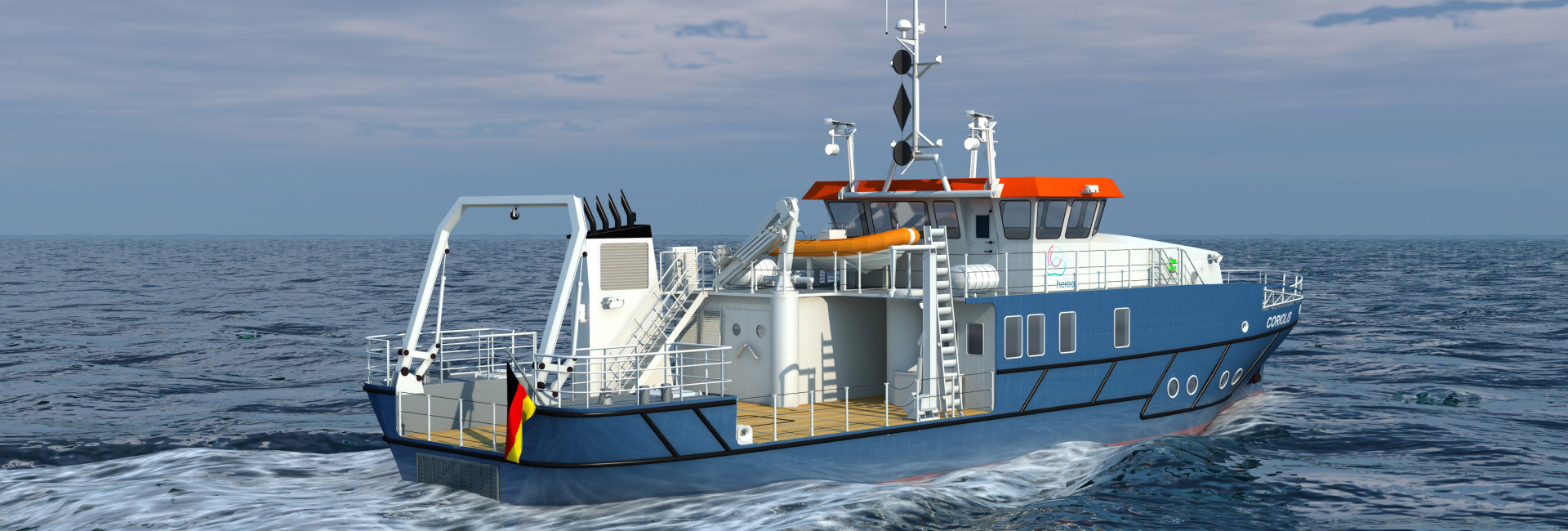The propulsion
The Coriolis is driven diesel-electrically and battery- or hydrogen-electrically. The drive concept provides for electric traction motors that can draw power from generators, the battery or battery and fuel cell.
The hydrogen-electric propulsion
On board the Coriolis, a tank system using metal hydrides (MH) to store hydrogen is to be used instead of a conventional pressurised or liquid hydrogen storage tank. Such storage systems have been investigated since the 1970s and are now used on a large scale, e.g. in the U212 and U214 class submarines to supply their PEM fuel cells.
The advantage of using metal hydrides for hydrogen storage is that with them a higher volumetric storage density can be achieved than with 700 bar high-pressure tanks at a loading pressure of less than 100 bar - more than 50 g H2/l tank volume at system level compared to about 35 g H2/l - and similar to liquid hydrogen (about 60 g H2/l), but at ambient temperature instead of -253°C. Moreover, the chemical bonding of the hydrogen makes it impossible for the entire quantity of hydrogen in the tank to be released abruptly in the event of a rupture of the closure valve or bursting of the pressure vessel of the MH tank (except for a residual quantity of approx. 5 - 10%, which is due to the unavoidable porosity of the storage material and spaces in the tank vessel not filled by the MH).
On board the Coriolis, it is to be demonstrated that a modular MH tank system, consisting of individual tank modules connected in cascade to form a series of tank units, is capable of supplying a 100 kW fuel cell with hydrogen as required, a high level of energy efficiency is achieved through the use of waste heat, the entire system can be operated safely on board a ship on inland and maritime waters, and emission-free driving conditions of the Coriolis can thus be achieved for several hours. Furthermore, the built fuel cell tank system is to be used to validate and improve a digital twin, i.e. a computer-based simulation model for the system with measurement data from real operation.
The diesel-electric propulsion
To support the hydrogen-electric propulsion - especially on longer routes - the Coriolis also has a diesel-electric drive. This can be operated conventionally by the diesel generator on board or electrically by the stored hydrogen on board.
Cleaning the exhaust air: minimising emissions through membrane technology
The diesel propulsion (dedicated port diesel) on board the Coriolus is necessary, but like any diesel engine it emits harmful nitrogen oxides, among other things. Especially in port, this can be a big problem if there is no corresponding shore power connection. Scientists at the Hereon Institute for Membrane Research are therefore working on a membrane module to minimise the emission of these pollutants. They are not focusing on the pollutants in the exhaust gas, but on the combustion air, i.e. the air that is burnt in the engine.
The idea is to attach a membrane module to the engine that separates the oxygen from the combustion air. In return, the built-in membrane allows oxygen to flow through better than nitrogen. This lowers the oxygen content in the retained combustion air - in this case from 21% by volume to about 18% by volume. As a result, the temperature of the combustion air also drops. And if this temperature drops, the proportion of nitrogen oxides produced during combustion also drops. Thus, nitrogen emissions are reduced by 80%.
But the gas stream that is initially discharged can also be reused. Since it contains more oxygen than normal air, a way is being sought to couple it sensibly into the ship's gas and energy system.
Weitere Informationen auf der Seite des Instituts für Membranforschung
Background: Metal hydrides
Metal hydrides store hydrogen by gaseous hydrogen penetrating a metal alloy at a certain loading pressure (max. 60 bar on board the Coriolis), forming a chemical bond with the metal and thus forming the MH. Like any chemical reaction, the formation of MH is characterised by a certain heat of reaction, which depends on the metal alloy used, as well as by an additional reaction rate, which depends on temperature and loading pressure.
The heat generated during MH formation depends on the amount of hydrogen that is brought to the reaction per time. In order to avoid overheating of the MH and the resulting slowing down of the hydrogenation reaction, the MH must be cooled accordingly or, in order to be able to store a lot of hydrogen quickly, a correspondingly high cooling capacity must be kept available. A typical cooling capacity for the metal hydride planned for the Coriolis (heat of reaction approx. 30 kJ/(mol H2)) is approx. 125 kW when storing the planned 30 kg H2 in one hour.
In order to store the hydrogen from the metal hydride, the necessary reaction heat must be reintroduced into the metal hydride. The output pressure of the stored hydrogen depends on the metal hydride and its temperature. For an electrical fuel cell output of 100 kW (electrical efficiency approx. 50%), a heat flux of approx. 25.0 kW must be supplied at a temperature of around 50°C. This heat flux can be easily determined via the heat exchanger. This inflow can easily be realised via the cooling liquid of the planned PEM fuel cell and in this way reduces the external cooling requirement for the fuel cell.
